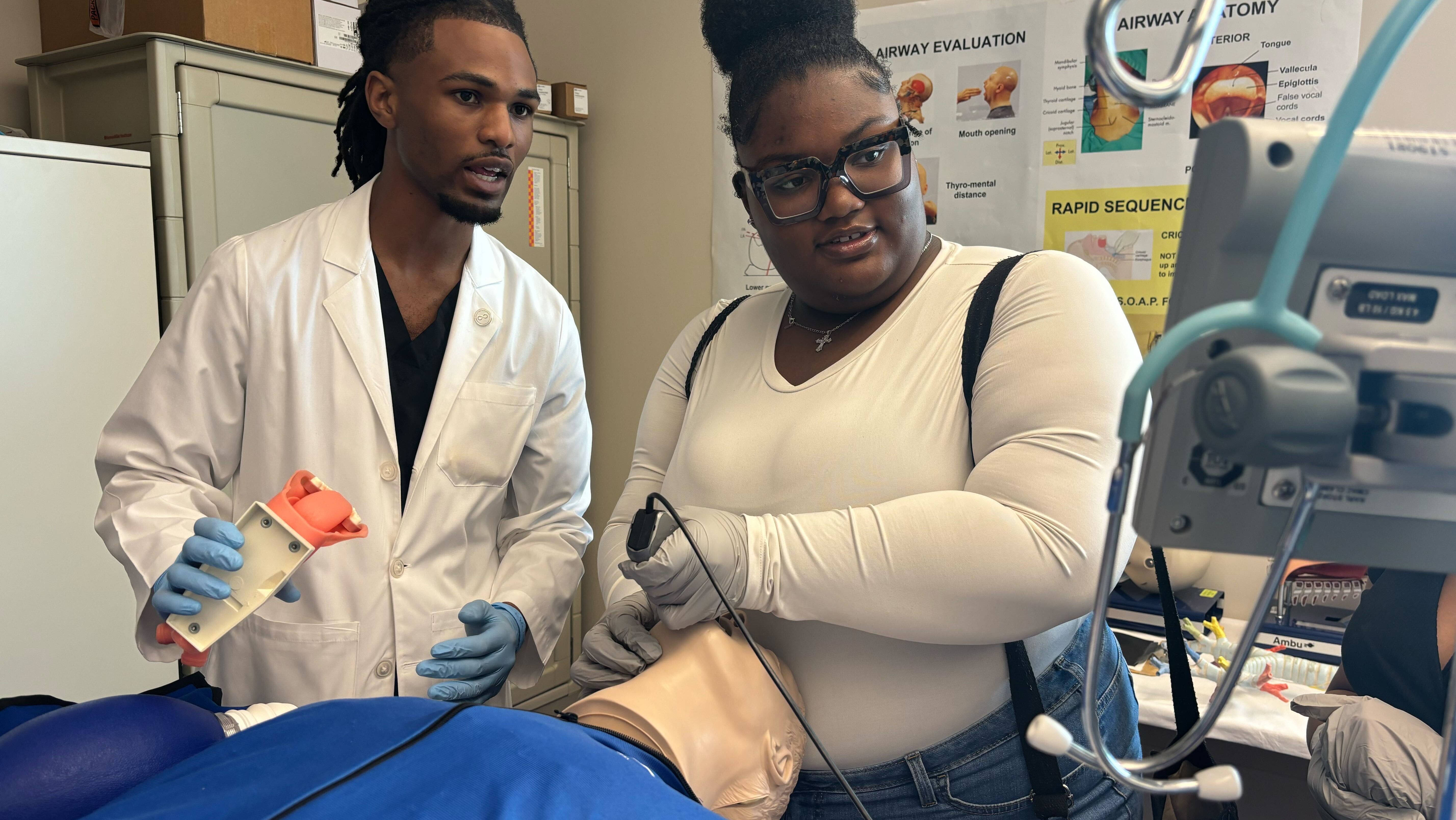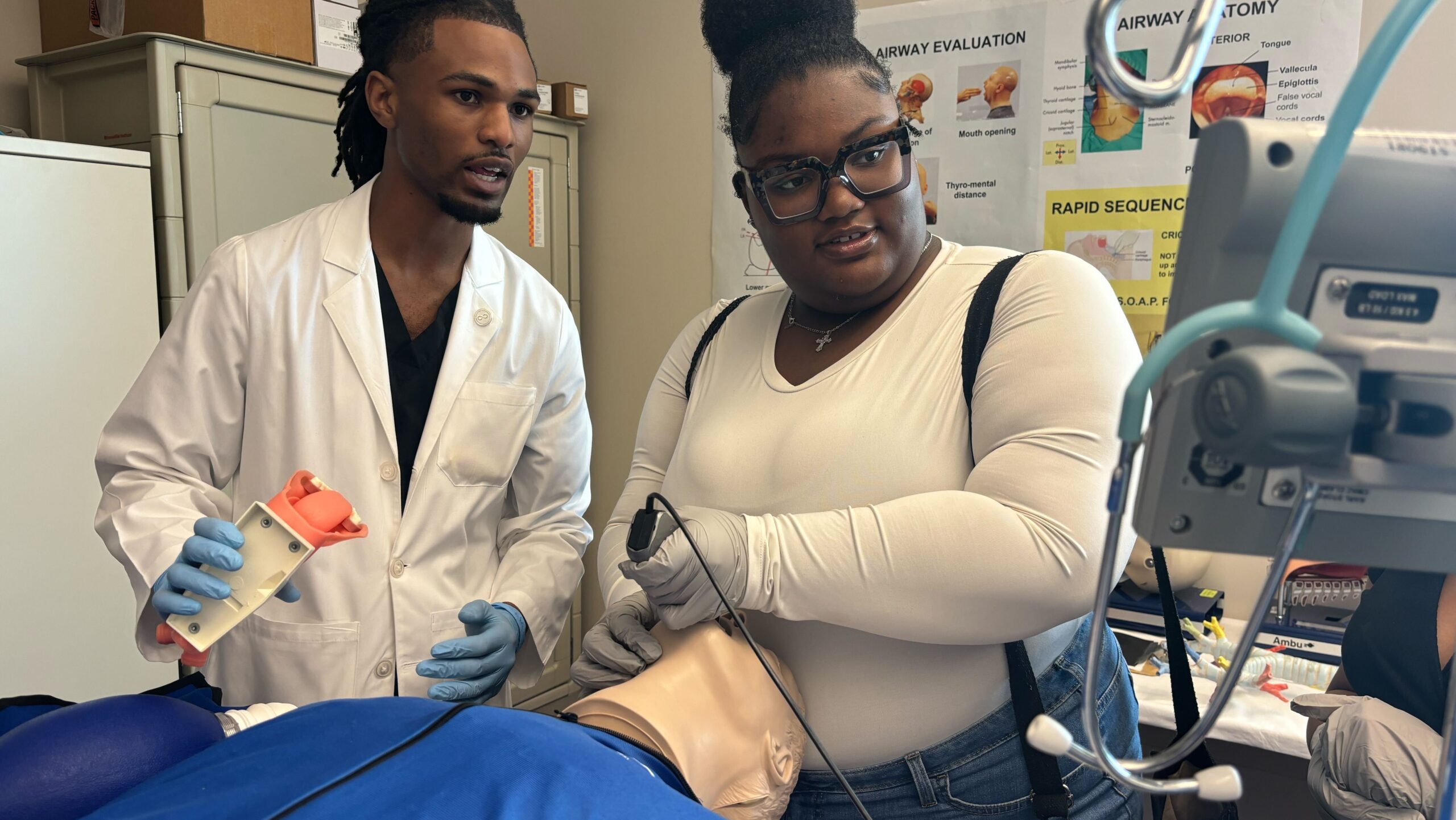
Jerrian Reedy was nine when his father was admitted to the hospital in Hattiesburg, about two hours northeast of New Orleans, after sustaining three gunshot wounds. Reedy recalled visiting his dad in the intensive care unit that summer in 2009, even though children weren’t typically permitted in that part of the hospital.
“Just seeing him laid up in bed, in a hospital bed, it was traumatizing, to say the least,” Reedy said.
His father died within a week of being admitted, in the middle of a nine-month span when Reedy also lost an aunt and a grandmother. “They say death comes in threes,” he said.
That chain of events prompted him to pursue a career in medicine, one that might help him spare other children from losing loved ones too soon.
Fifteen years later, Reedy has completed his first year at the University of Mississippi School of Medicine — a remarkable feat, and not only because his career path was born of grief and trauma. Reedy is among a small share of Black medical school students in a state where nearly 4 in 10 people — but only 1 in 10 doctors — identify as Black or African American. Of the 660 medical school students enrolled in the same four-year program as Reedy, 82 students, or about 12%, are Black.
Medical schools around the country are trying to recruit Black, Hispanic, and Native American students, all of whom remain disproportionately underrepresented in the field of medicine. Research has shown that patients of color prefer seeing doctors of their own race — and some studies have shown health outcomes are better for Black patients seeing Black doctors.
But a recent swell of Republican opposition threatens to upend those efforts, school administrators say, and could exacerbate deep health disparities already experienced by people of color.
Since 2023 — the year the Supreme Court voted to outlaw affirmative action in higher education — more than two dozen states, including Alabama, Florida, Mississippi, North Carolina, and Texas, have introduced or passed laws to restrict or ban diversity, equity, and inclusion, or DEI, programs.
“I don’t expect this movement of anti-DEI legislation to slow down or stop at all,” said Anton Gunn, a health care consultant and former head of the Office of External Affairs at the U.S. Department of Health and Human Services. “And it likely will exacerbate if Donald Trump gets the opportunity to be president of the United States again.”
Diversity Programs Face Pushback
In 2023, Florida and Texas became the first states to pass laws that banned DEI efforts in higher education. Several other states, including Idaho, North Carolina, and Wyoming, passed laws targeting such programs this year.
In Mississippi, state Rep. Becky Currie and state Sen. Angela Burks Hill, both Republicans, introduced separate bills that would have restricted how colleges and universities could spend money on DEI initiatives. Both bills died in legislative committees and were not brought before the 2024 legislature for a vote.
In a statement, Hill said that Mississippi needs more doctors of all kinds, not just more Black doctors, and that she thinks money spent on DEI salaries and programs should be reallocated to initiatives benefiting all students.
“Qualifications should determine who gets into medical school not color or socioeconomic status,” she said. “Can’t we just be happy with more highly qualified doctors no matter their skin color? I thought a color blind society was the goal.”
Nationally, the movement to ban DEI programs has broad conservative support.
Jay Greene, a senior research fellow at the Heritage Foundation, a conservative think tank, said he believes diversity programs “fail for a hundred reasons.” He cited research he conducted with a conservative medical advocacy group called Do No Harm refuting the premise that access to Black doctors improves health outcomes among Black patients.
“That doesn’t mean there’s no potential benefits for having greater diversity in the doctor workforce,” Greene said. Having more Black doctors, for example, might encourage more Black children to consider a career in health care, he said. “But that benefit is not health outcomes.”
Meanwhile, school administrators are closely watching the progress of such laws.
In March, the University of Florida eliminated all DEI programs and terminated jobs related to those efforts. In Alabama, lawyers and school leaders are grappling with a bill signed the same month by Republican Gov. Kay Ivey that bans DEI programs in public schools, state agencies, and universities starting Oct. 1.
“We have to be very, very careful,” said Richard deShazo, who teaches at the University of Alabama’s Marnix E. Heersink School of Medicine in Birmingham and used to chair a committee that raised money for Black medical school students.
“You cannot raise money for Black kids. You have to raise money for medical students,” he said.
A Bitter History
A shortage of Black doctors isn’t unique to Mississippi. The same story could be told in many other places, especially across the South, where more than half of all Black Americans live and where health outcomes regularly rank among the worst in the United States.
But a look at Mississippi, one of the unhealthiest states in the country, shows how the roots of systemic racism continue to shape the nation’s health care workforce.
“A lot of the Black physicians in the state have a bitter taste in their mouth about our medical school,” said Demondes Haynes, associate dean of medical school admissions at the University of Mississippi Medical Center, where he graduated in 1999 as one of four Black students in his class.
An estimated 1.1 million Black people live in Mississippi, where there are fewer than 600 Black doctors. Research suggests health outcomes would improve if there were more. One study published last year in the medical journal JAMA Network Open found that life expectancy was longer among Black patients in counties with higher ratios of Black primary care physicians.
In a study based in Oakland, California, that involved more than 1,300 Black men, those who were assigned a Black doctor were more likely to agree to screening tests for diabetes, cholesterol, and other health concerns, according to the findings published in 2018 by the National Bureau of Economic Research.
“We absolutely are not saying every Black patient has to have a Black doctor,” Haynes said. But because the patient population in Mississippi is diverse, “they should at least have the right to say, ‘This is what I want,’” he added.
However, most Black patients aren’t afforded that choice. Nearly two dozen of Mississippi’s 82 counties have no Black doctors, while four counties claim no doctors at all, according to a physician workforce report published by the state in 2019.
For more than a century, dating to its founding in the mid-1800s, the University of Mississippi didn’t admit Black students — and that policy applied to its medical school. In 1972, nearly 10 years after the Civil Rights Act of 1964 banned racial segregation in higher education, the first Black physician graduated from the medical school in Jackson. Even then, very few Black students were admitted to study medicine there each year.
Before the federal government banned the school from rejecting Black applicants because of their race, aspiring Black doctors who applied were diverted to one of the historically Black colleges and universities, or HBCUs, such as Meharry Medical College in Nashville, Haynes said.
Many older Black physicians in Mississippi still remember getting those rejection letters, he said, pointing out composite photographs of physician graduates that line the walls of the medical school building in Jackson. Many of the earliest composites, dating to the 1950s, showcase classes of all-white, and almost all-male, students.
“Mississippi history — everybody remembers it,” Haynes said. “And those people who experienced it, it’s hard for them.”
Recommended Stories
‘Shaping the Possibilities’
On a damp Saturday morning in mid-April, 17-year-old Dorothy Gray, a high school junior, stepped up to a hospital bed at the medical school in Jackson to intubate a mock patient in a simulation lab.
Gray was one of more than 100 high school and college students who attended the University of Mississippi School of Medicine’s annual African American Visit Day, established more than 10 years ago to foster interest among prospective Black students. The administrators, who also host special visiting days for Hispanic and Native American students, said anyone, regardless of race or ethnicity, may attend. They acknowledge that most attendees won’t become doctors, and their purpose isn’t to extend preferential treatment to minority applicants.
“This is about shaping the possibilities of what could be,” said Loretta Jackson-Williams, the school’s vice dean for medical education. “These kids are at that precipice where they can choose to do something that’s really hard for their future or they can choose an easier pathway. That choice doesn’t come about overnight.”
Besides African American Visit Day, medical school leaders in Mississippi also offer a test prep program for applicants from underrepresented backgrounds who have been rejected from medical school.
The school recently identified 16 applicants, 12 of whom are Black, who were not accepted to the medical school during the last admissions cycle because their MCAT scores were too low. This year, those applicants will receive a test prep course designed by The Princeton Review — free of charge — and will have a chance to meet with administrators to learn how their medical school applications might be strengthened.
“So many students have never had someone tell them, ‘You can do this. I believe you can do this,’” said Dan Coleman, the medical school’s outreach director.
For Jerrian Reedy, who wants to become an orthopedic surgeon, the path to medical school was years in the making. He took advantage of the University of Mississippi Medical Center’s PROMISE program — short for Promoting Recruitment Opportunities in Medicine with Individual Study Experiences — which assures acceptance to students from disadvantaged backgrounds who meet certain eligibility requirements, including a 3.0 GPA in their undergraduate science classes.
During his sophomore year as an undergraduate, Reedy saw an opportunity to learn more about medical school when Haynes, the assistant dean, visited the Ole Miss campus in Oxford to interview students.
“I saw some open slots, put my name down,” he said. “The rest is history.”
KFF Health News is a national newsroom that produces in-depth journalism about health issues and is one of the core operating programs at KFF—an independent source of health policy research, polling, and journalism. Learn more about KFF.





